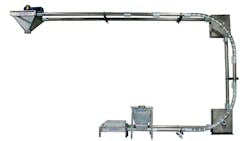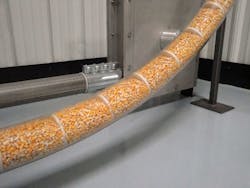Best-in-class hygienic options for food processing conveyors
As legislation across the globe like the Food Safety and Modernization Act (FSMA) and the Food Standards Act continues to shift the focus from responding to foodborne illness to preventing it, food processors must rise to meet the highest sanitation and hygiene standards in the industry.
The hygienic design, cleanability and durability of processing equipment is essential in controlling the microbiological safety and overall quality of processed goods. And when it comes to the hygienic conveying of dry bulk foods and powders, totally enclosed, tubular conveying systems are the gold standard.
Tubular, closed conveyors prevent product contamination by fully sealing off the product from its outside environment (vs. traditional open conveyor systems like bucket elevators and flat belt systems). But even among fully enclosed conveyors, food processors must consider differences in conveyor options and features — as they relate to design, cleanability and durability — in order to achieve a best-in-class hygienic system.
Tubular food processing conveyors: Best-in-class hygienic features checklist
This checklist of features and options are meant to help inform decision-making process when evaluating a tubular drag conveyor purchase and to identify any needs to upgrade existing conveying equipment with hygienic features and add-ons. Read on to learn about appropriate materials for specific food conveying needs, design options that prevent food build-up and product contamination, features to minimize maintenance and downtime, and quick and easy complete cleaning options.
Design
Look for these design features help to prevent product build-up and cross-contamination:
FDA-compliant materials
Check to make sure that all parts of the processing equipment in contact with food products are made from an appropriate grade and finish of stainless steel or from other FDA-compliant materials. For example, FDA-compliant nylon coated cables can help to minimize product contact with the metal stranded cables used in cable drag conveyors that may otherwise create harborage points for bacteria.
Prevent product contamination with metal
As mentioned, a cable coated with FDA-compliant coating is a great way to prevent metal strands from breaking off from a cable and contaminating food product. As a hygienic plus, a coated cable will minimize crevices in the metal cable and prevent materials from being caught in the cable, and it is easier to clean and clear of dust that may form during conveying of dry materials.
Crevice-free, rounded design
A simple, crevice-free rounded design prevents food product accumulation — and the resulting risk of festering microorganisms and microbial contamination. Additionally, designs with fewer bolts and fasteners help to prevent product contamination from parts that may break off into the product with wear and tear.
Sanitary seal
Ask if a conveyor manufacturer offers designs that contain a seal to separate the drive system from the material in the event of material leakage. A sanitary seal consists of an outboard seal and stand-off between the drive and the conveyor outlet.
Rotating tube valve
Rotating tube valves are another hygienic design element that help eliminate product accumulation in product discharge points. This design eliminates the pocket of residual material that can sit between the conveyor and outlet slide gate on many traditional outlet designs, and can significantly reduce cross-contamination issues. Ask if the system has any areas where residual product will sit in between successive activations of a valve or outlet, as this can increase the risk for microbiological safety.
Cleanability
Any tubular, enclosed conveyor on the market can be properly cleaned with enough time and effort. But time spent cleaning means time lost in production. Thus, food processors should look for the following cleaning options that allow for fast, easy, regular cleanings without significantly interrupting production lines.
Clean-in-place (CIP)
Clean-in-place options allow the conveyor to be cleaned without completely disassembling it. There are two different options for CIP solutions: dry cleaning using a combination of brushes, wiper disks and air knives, or a full wet cleaning by flushing the tubes with water, foam or a suitable sanitizing fluid through dedicated wash-down and drain ports.
Dry CIP features include air knives inserted at product discharge locations — the compressed air helps to blow away build-up. Brush boxes are another option; the in-line bristles physically scrub dust and build-up of the tubular drag discs. Clean-out or wiper discs are oversized discs that are run through the conveyor to remove debris and build-up in the tubes. A cleaning agent may also be applied to the disc.
A self-washing or automated, wet CIP system considerably speeds the cleaning process compared to manual dismantling and subsequent reassembly of the conveyor for cleaning. Ask about both wet and dry clean options and whether they are right for your application. In the case of wet clean options, hot air can be blown through the tubes to dry them quickly.
Quick release
While regular CIP options can help to minimize downtime, plant personnel may still need to periodically dismantle the tubular conveyor to reach and clean specific parts of the system. In addition to the tubing, the chain or cable may need to be completely removed for cleaning at regular intervals based on the product conveyed and environment. Quick-release connectors enable rapid dismantling and reassembly of tubing to minimize downtime. Ensure that any quick-access designs, including pull out trays, are also watertight.
Clamp-on conveyor disc camera
Some manufacturers offer a specialized camera that can be used to inspect the inside of the tube for areas that are experiencing build-up and offer a way to double-check where your system may need to be cleaned.
Durability
The durability of a tubular conveyor and cable or chain is directly linked to equipment hygiene. Look for these durability characteristics and options to complement and support specific hygiene and sanitation requirements.
Automatic rope tensioner
Worn cable or chain can fray or break off and risk product contamination. And all cable and chain products are expected to experience wear and become stretched out over time. An automatic rope tensioner can help to keep the cable or chain tensioned properly to increase the life of the cable or chain and disc assembly.
Materials built to handle frequent cleanings
Tubular conveyors should be built with materials that can stand up to the type and frequency of planned cleaning and sanitation. Make sure to evaluate durability in relation to the planned method of regular cleaning.
Prevent downtime
Durability also means less unplanned downtime, which can leave product sitting and provide time for microorganisms to grow. If purchasing a cable or chain, ask about the material used. And remember that chain is not necessarily more durable than cable. In fact, cable can exhibit a greater tensile strength than chain. Some manufacturers can offer aircraft grade 304 type stainless steel cable. This material has superior rust and corrosion resistance to stand up to wear and tear and frequent cleanings. Additionally, make sure that the discs are made of a material that meets any high temperature requirements. For example, for extremely high temperature applications (up to 300°F), ask about upgrades to cable material where standard polyurethane many not meet the requirements.
Ready to upgrade? Test first
Wondering which cleaning solutions will work best for a specific application and material? Test or demo units may be available from conveyor manufacturers to test the levels of cleaning and sanitation that could be achieved by a sanitary or CIP unit. Check with a conveyor manufacturer to understand what on-site testing options may be available.
Andy Forrester has more than 20 years of experience in senior-level roles across the powder and bulk solids, manufacturing and construction industries. Today, he serves as the vice president of sales for the Americas for Spiroflow Systems, Inc.
About the Author
Andy Forrester
VP of Sales, Americas, Spiroflow Systems, Inc.
Andy Forrester, a former Royal Air Force officer, has over 20 years of experience in senior-level roles across the powder and bulk solids, manufacturing, and construction industries. Today, he serves as the Vice President of Sales for the Americas for Spiroflow Systems, Inc. (www.spiroflow.com). You may reach him at [email protected] or at (704) 246-0953.

